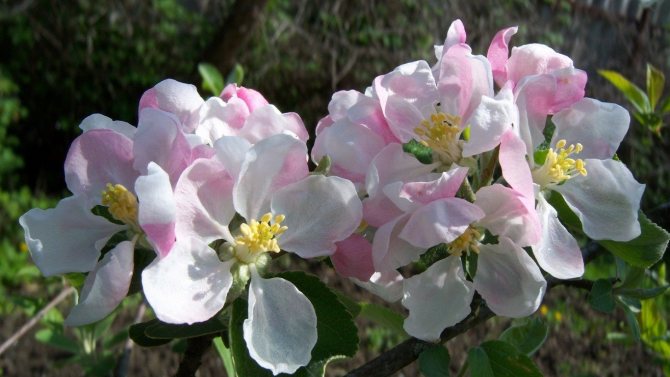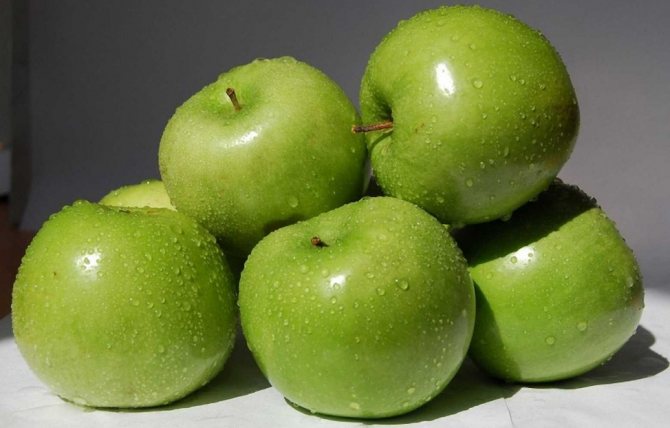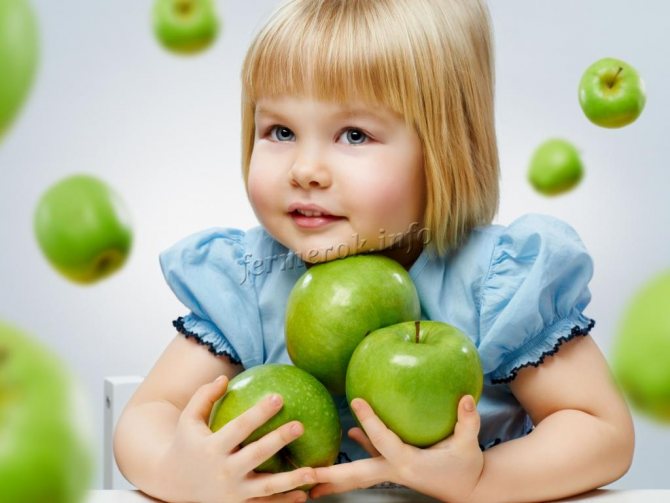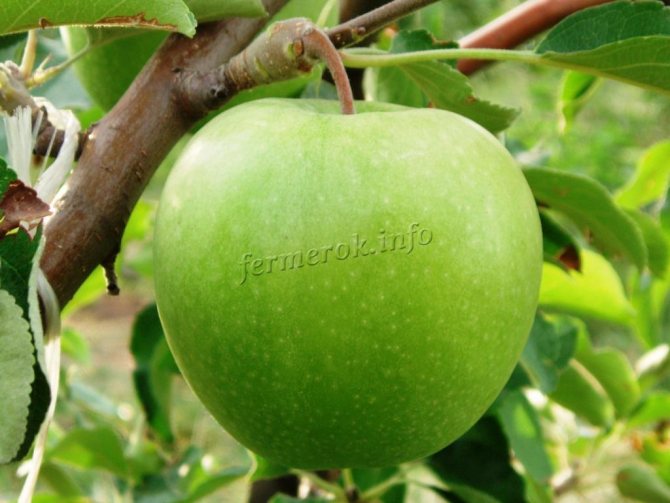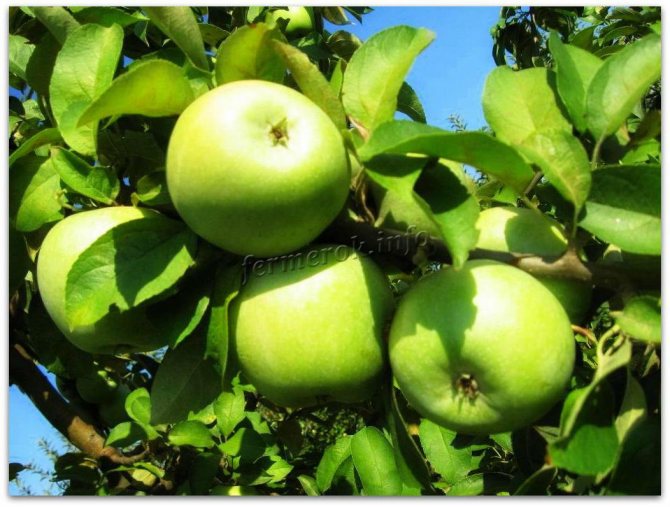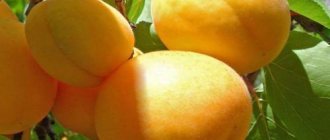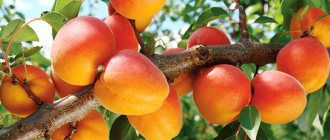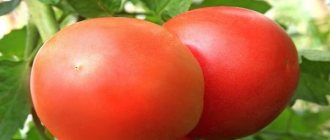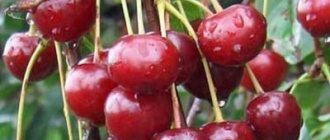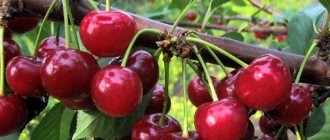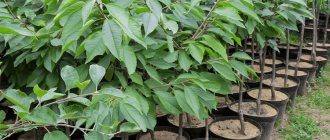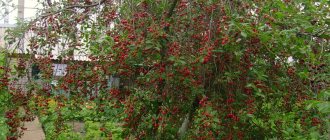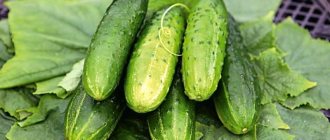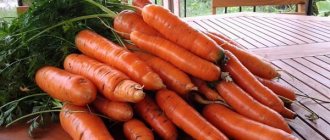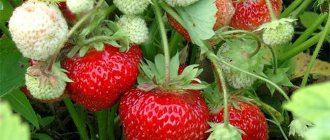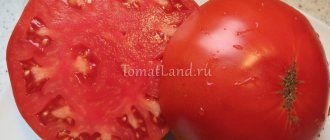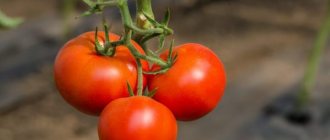Gardening »Apple tree
1
442
Article rating
Semerenko (or Simirenko) apples are delicious winter fruits familiar to many from childhood. The variety was bred in the 80s of the last century, in the village of Mliev, Kiev province. The creator named it after his father, Platon Semerenko. The half-forgotten English variety Zelenka Vuda was taken as a basis, but the taste of the new apples has improved significantly.
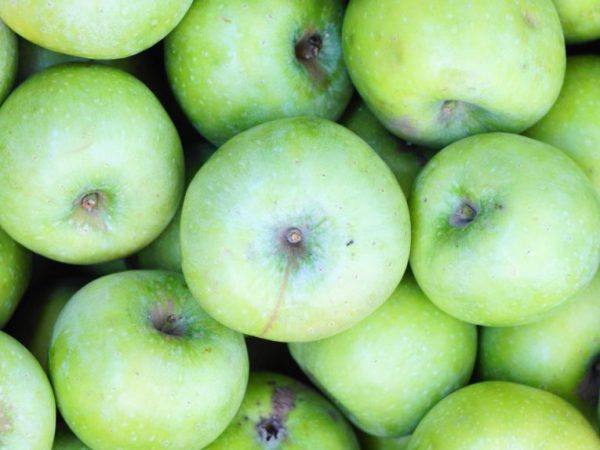
Apple tree Semerenko
Apple tree Simirenko is a primordially Russian variety, unknown in Europe, but very popular throughout the southern part of Russia and the Central Black Earth Region. It has become widespread in Ukraine as well.
The Simirenko apple variety was entered in the State Register of the Soviet Union in 1947.
Dignity varieties:
- Good productivity;
- Early maturity;
- Long-term storage of apples;
- Resistant to heat and drought;
- Large size of apples.
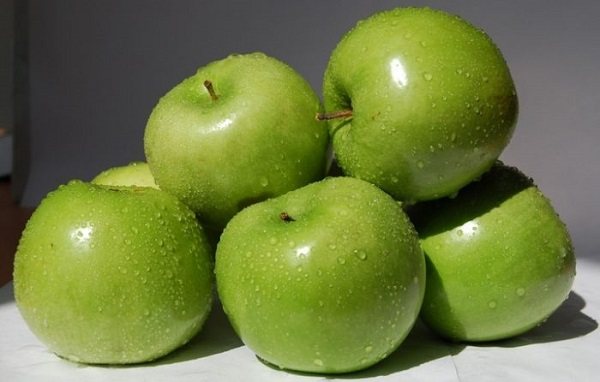

Large fruits are one of the advantages of the Simirenko apple tree.
disadvantages varieties:
- High susceptibility to scab and powdery mildew;
- Tendency to thicken the crown;
- The frequency of fruiting in adulthood.
- Low winter hardiness;
To grow this apple tree climatic zones with mild and warm winters are suitable, such as Krasnodar Territory, North Ossetia, Georgia, Abkhazia, North Ossetia, Ukraine.
Further in the article, we present to your attention a description, photo and opinion of gardeners about this variety.
Pros and cons
Among the advantages of the Semerenko variety are:
- high presentation of apples;
- the crop tolerates long-distance transportation and long-term storage;
- trees begin to bear fruit earlier than most other varieties, and the harvest is always large and stable;
- trees tolerate dry weather well.
Culture has its drawbacks, the presence of which should be taken into account before planting in your garden:
- the tree does not have the strongest immunity;
- annual pruning of branches is required;
- does not tolerate a strong drop in temperature;
- old apple trees begin to malfunction, fruits do not form on them every year;
- cross-pollination is required to form ovaries.
Characteristic
Wood
Tall, with wide-round spreading crown. The bark on the trunk and branches is dark gray, with an orange tint on the sunny side.
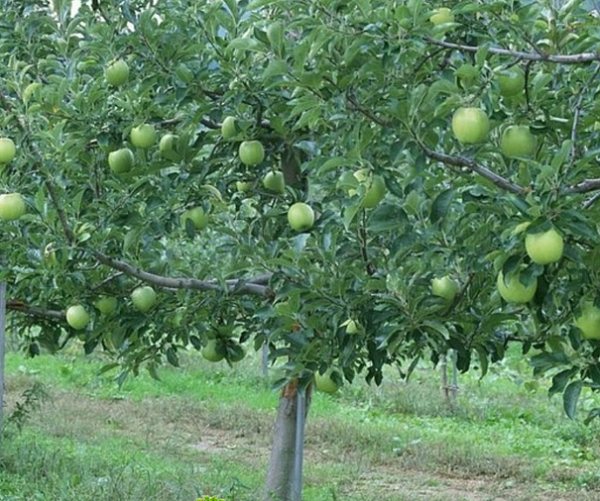

Apple tree Semerenko.
Escapes
Straight, green-brown, of medium thickness. Their lentils are small and rare.
Annual growth of shoots
Provided proper agricultural technology reaches 50-60 cm a young seedling and 45-55 cm in an adult.
Leaves
Elongated, ovoid, curved boat-shaped at an angle of up to 90 °. Them the tip is twisted. The color of the leaf is light green, and the surface is slightly shiny, with fine serration at the edges.
Fruit
Medium-large or large, the correct rounded shape; their surface is flat and smooth. With the technical ripeness of them color light green, apples turn yellow during storage. In fruits growing in the sun, often a faint pink blush appears.


Simirenko's apples.
Average apple weight - 150-180 gr., when rationing the yield, the weight rises to 200 grams.
Important! Crop rationing is the removal of part of the ovaries from the tree.
On the entire surface of the fruit there is many subcutaneous points - light and large, 2-3 mm in diameter.
The apple pulp is creamy white, very tender and juicy.The taste is sweet, with a pleasant aftertaste of spices. The content of sugar in the pulp is from 8 to 12%, and acids - 0.4-0.7%. The content of ascorbic acid is 8 mg per 100 g. fetus.
You can evaluate the fruits of the Semerenko apple tree in the following video:
Tasting assessment
4.5-4.7 points.
Yield
High. They remove from an adult tree 140-170 kg harvest. An eight-year-old tree produces 12-15 kg of apples.
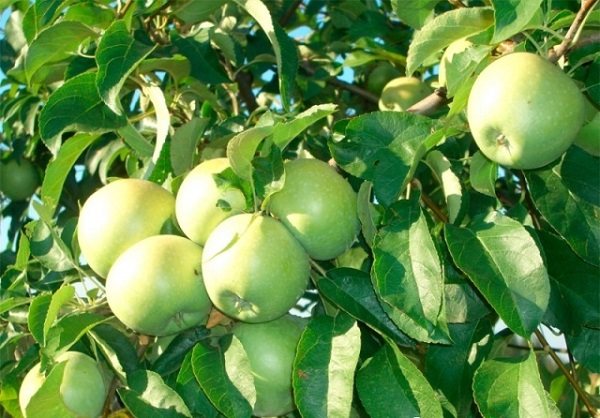

The Semerenko apple tree is characterized by high productivity.
Early maturity
Good. The tree forms the harvest 4-5 years after planting.
Timing
Flowering
Second half of May.
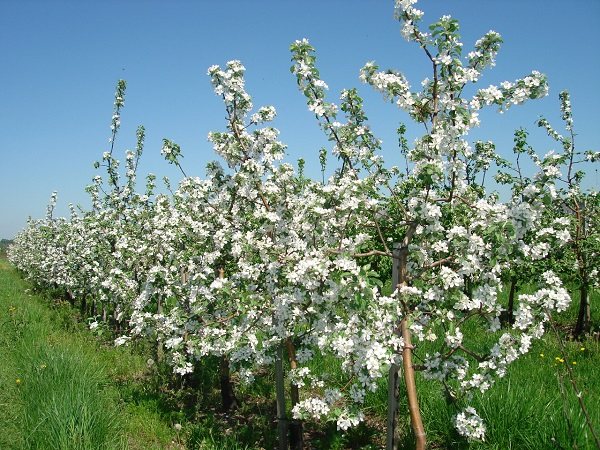

Apple blossom Semerenko.
Fruit ripening
Second half of September - mid-October.
Harvest storage
Until next summer. Storage until the next harvest is possible.
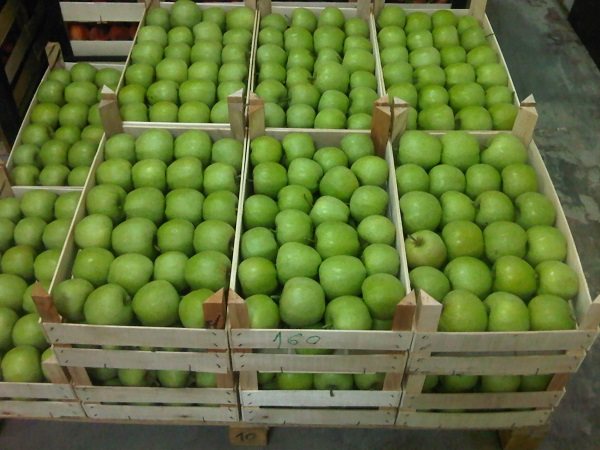

Renet Simirenko can be stored until the next harvest.
Winter hardiness
Low, the tree is severely damaged by frost at a temperature of -25 ° Ϲ.
Disease resistance
Below average especially for scab and powdery mildew.
Pollinator varieties
The best varieties for Simirenko are considered:
- Idared;
- Korah;
- Golden Delicious;
- In memory of Sergeev;
- Kuban Spur.
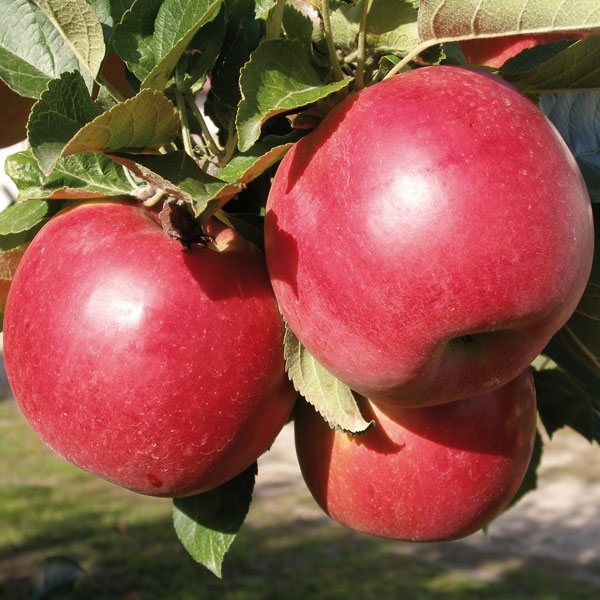

Idared.
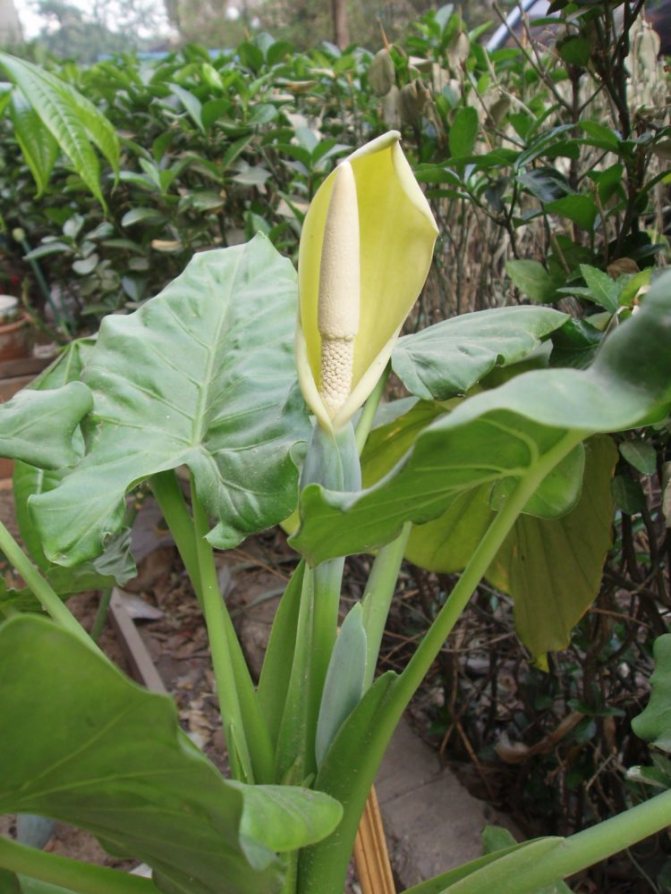

Korah.
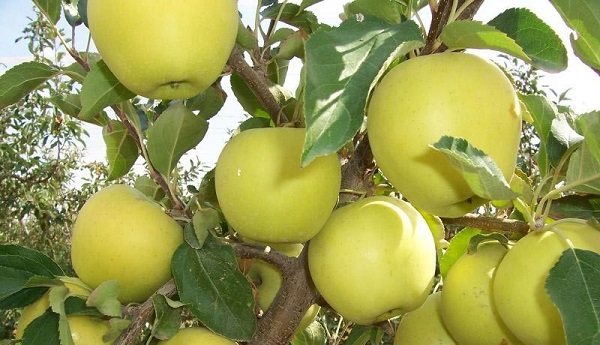

Golden Delicious.
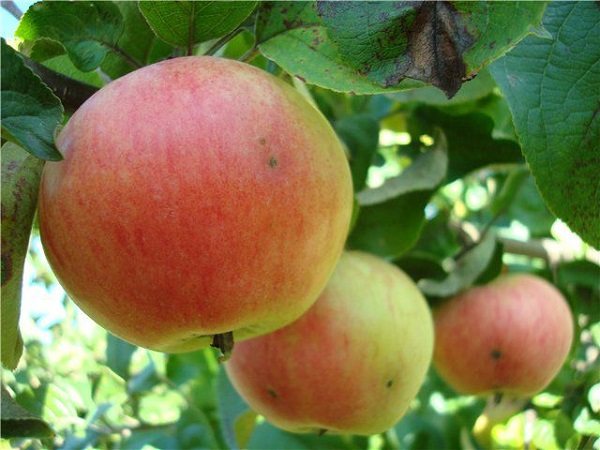

In memory of Sergeev.
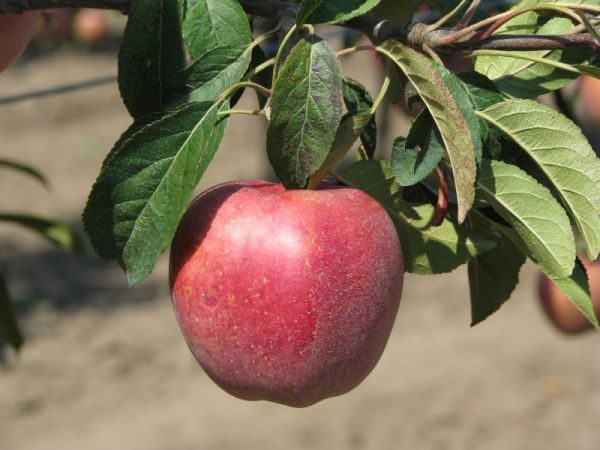

Kuban Spur.
See an overview of the Semerenko apple tree in the video below:
Renet Simirenko, apple tree: description of botanical features
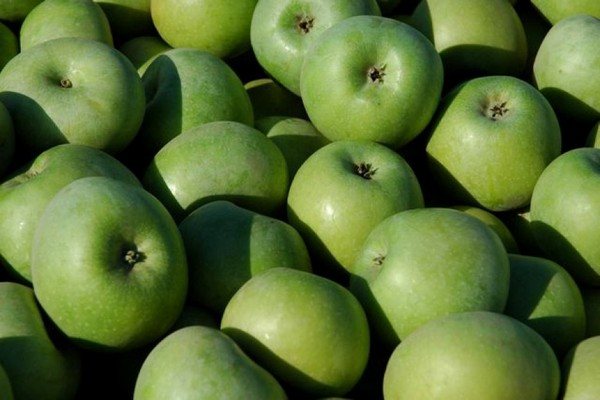

Renet Simirenko, apple tree: description
Renet Simirenko belongs to rather tall apple trees, and therefore the trees of this variety grow very tall and massive, and their crown also has incredibly impressive dimensions, making the whole tree as a whole looks incredibly large and spreading.
It is also worth noting that the crown of the tree, in addition to its massiveness, is also quite neglected, and therefore a huge share of all the energy required for growing fruits, the tree receives directly from the sun.
The color of the bark of the branches in this tree is dark gray. At the same time, small brown veins can be traced on them.
The leaves have an uneven shape. They are rather oblong, and only slightly pointed at both ends. It is also impossible not to notice that the leaves are incredibly smooth and dull, and they do not even have any jaggedness on the sides.
Flowering, as you can already understand, based on the characteristics of the variety, this tree is quite late. Small white flowers begin to appear on it, after the flowering of which - already in the middle of autumn you will be able to harvest your crop.
At the same time, the fruiting of this tree is mixed, which means that flowers are tied on absolutely all shoots: from old ones to those that have grown this year, and therefore, when pruning, you should keep this in mind and not remove those branches that can still benefit you.
In addition, it should be noted that it is rather difficult to distinguish old branches from new ones, since they practically do not change over time (except, of course, the length), and therefore we advise you to keep a record of branches, thanks to which you can prune more accurately and exactly.
Enough about the tree, however. You, of course, are interested to know what characteristics the fruits of this tree have. Apples of the Renet Simirenko variety are distinguished by their incredibly light green color, which, it should be noted, is rather uncharacteristic for trees of such late maturity.
Large white spots can also be noted on the fruits, which cover them mainly from the top and bottom. Thanks to these spots, the fruits appear a little bluish.
However, the fruits will still have time to change their appearance: if they stay in your storage until the summer, they will acquire a pleasant-looking blush.
By the way, if you notice small warts on the fruits, then you should not worry about this at all, since this is natural, and they will always form on the fruits of Renet Simirenko.
By the way, if we talk about other positive qualities of these fruits, then it should be noted that they have incredibly strong adhesion to the tree, and therefore, even with strong winds or shaking, they do not fall from the tree ahead of time.
As for the dimensions of the fruits under discussion, some gardeners characterize it as medium, and some as large.However, judge for yourself: the average weight of an apple plucked from a tree of the Renet Simirenko variety is approximately two hundred grams.
At the same time, their shape is not round at all, but has some approximations from below and on the sides. The skin is incredibly smooth and almost matte. Of course, we must not forget about the taste qualities of these fruits, which are truly exceptional. Also, tasters note that the fruits exude a very pleasant fruity aroma.
By the way, this variety is recommended not only by professional gardeners or breeders, but also by doctors, since it contains the least amount of sugar and anthocyanins, while retaining a sufficient amount of vitamins and other substances to be useful for the body.
Testimonials
This popular variety is often discussed on gardening forums.
Evgeny Sergeevich, 54 years old, Donetsk.‟My father planted Semerynka, and now this apple tree is already 50 years old. It is the largest on the site, gives a lot of shade. It does not bear fruit every year, but it produces large apples. "
Alena, Volgograd. ‟We have two Semerinko apple trees. One was bought tall, and the second - on a dwarf scion. Both grow well, but grow tall faster. They have been bearing fruit for 5 years already, but every year we fight with scab! In rainy years, powdery mildew also appears. I spray the entire garden 2 times a year so that the infection does not spread.
The apples themselves are tasty and juicy, and have a long shelf life! I put them in boxes in the basement, sprinkle them with dry sawdust, and we keep them until May. We would have stayed longer, but we eat them all))). ”
Vladimir, Chelyabinsk. ‟I planted this apple tree, not knowing about its low frost resistance. And now every year I cover it and throw snow to the trunk. In one year, all her branches were frozen, but over the summer she threw out new ones as much as a meter in length. And the next year it was already bearing fruit! Of the advantages, I would like to note its unpretentiousness. All she needs is insulation for the winter and treatment for mushroom sores. She does the rest herself. "
Yield
Renet Simirenko, unfortunately, cannot be praised for the fact that this tree quite early enters the age suitable for harvesting, However, it is also impossible to scold him for the fact that it ripens for ten years. It has a fairly average duration, which, however, can vary from six to seven years.
However, if you decide to grow a tree on a dwarf rootstock, you may well be able to get the first apples from it already in the fourth year of life.
Unfortunately, it should also be noted that older trees, the age of which have already passed about eighteen to twenty years, begins to observe a significant periodicity in singing along with the fruits: only once every two years you will be able to get a full harvest, and in other years the number of apples will be lose weight significantly.
However, this does not apply at all to young trees, and therefore you can always collect the maximum from them.
As for more specific figures, in their first years the trees bring no more than twenty kilograms of apples, but already in your first ten you will be able to collect about a centner from them, if, of course, you provide the tree with quality care.
Most often, you need to be ready to harvest sometime in late September or early October. This variation depends both on your departure and on completely unpredictable factors such as weather conditions.
Landing
Growing conditions
Apple tree Renet Simirenko loves fertile and breathable soils... It tolerates heat and drought well and can grow on hills and small hills that are poor in moisture.
Timing
The Simirenko apple tree is planted at the same time as other apple trees: from mid-April to mid-May in the spring, and from late September to mid-October in the fall.
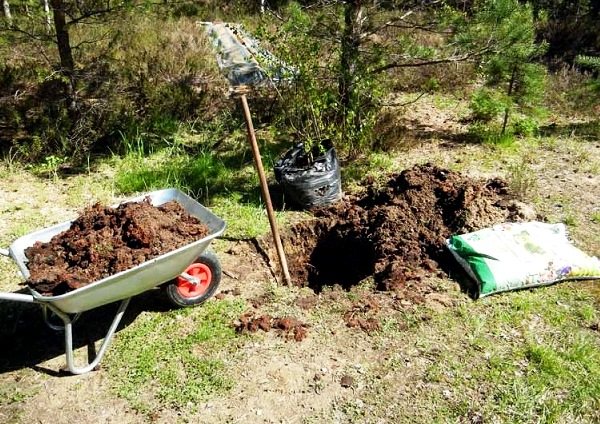

Semerenko can be planted both in spring and autumn.
Technology
Dig a planting hole 50 cm wide and deep, loosen the bottom with a shovel. For heavy soils, the pit is made larger, approximately 70-80 cm in width and depth, and the removed soil is diluted with sand:
- Drive a strong peg 1.5-2 meters long into the bottom of the pit.
- Shorten the roots of the seedling by 3-4 cm, remove the broken and dented roots.
- At the center of the hole, make a small slide, and place the roots of the apple tree on it, carefully spreading them in different directions.
- Fill the hole with soil, crushing it with your hands, and tie the seedling to the peg.
- Pour 2-3 buckets of water over the tree.
Advice! If you prepare the hole in advance, 1-2 weeks before planting, it will be better saturated with moisture, and the deep layers of the soil will be saturated with oxygen.
Watch the video on how to plant apple trees correctly:
Scheme
Apple tree Simirenko has remarkable growth power and is capable of spreading 4.5-5 meters wide. Due to the dense crown, it strongly shades the ground beneath it and this must be taken into account when planting it next to other plants.
So that all plants have enough light, the Simirenko apple tree planted at a distance of 4.5-5 meters from other trees. If your seedling is grafted onto a semi-dwarf stock, the distance can be reduced to 3.5-4 meters.


Planting scheme for apple trees, depending on the stock.
Features of growing Simirenko
Landing
Basic conditions
- For disembarkation, you need to select a large enough area where nothing will interfere with the tree within a radius of 6-7 meters. He needs space so that neither his roots nor branches clash with other plants.
- The variety loves airy soils, but fertile enough, therefore, fertilizers will have to be regularly applied to sandy or loam so that the tree bears fruit abundantly and grows well.
- Simirenko's resistance to droughts and heat is very high, so it can be planted on hillocks, far from groundwater - the apple tree itself “gets to moisture.
- In light soils, a hole of 50 centimeters deep and in diameter is enough, but in heavier soils it will be necessary to dig up to 60-70 centimeters to leave space for laying river sand and drainage.
- It is advisable to dig holes in advance, not less than 3-4 weeks before planting. They need to put fertilizers mixed with the soil, pour water and leave it all under the open sky.
- Garter stakes are immediately driven into the hole, preferably from the north side.
- It is not necessary to soak the seedlings of this variety before planting, but it is advisable to shorten all the roots by 3-4 centimeters. It also does not hurt to cut off all dried and damaged pruning shears.
- The root collar should protrude above the ground by at least 5-7 centimeters when it comes to dwarf or semi-dwarf rootstocks. Otherwise, the tree can root above them, then all additional properties will be completely leveled.
- Trees are sprinkled with earth and simply crushed with hands, without trampling. You need to spill 30-40 liters of water.
Disembarkation dates
It is not very important for this tree whether you plant it in spring or fall. The main thing is that it has time to take root before the onset of frost or does not capture the spring frost, because a weak seedling can die from such stress. In the spring, it is best to do this around the middle or end of April, and in the fall in late September or early October.
Frost and rodent protection
To get good harvests, and not to lose the tree at all, you will have to cover it well from frost. The trunk circle, trunk and even skeletal branches are best wrapped with special materials, covered with spruce branches, tar paper, roofing felt, hay or straw sheaves. Even wrapping with nylon tights can give a good effect. True, at extremely low temperatures, which will last a long time, no tricks will help and the trees will most likely freeze over.
In order for insects not to settle in the near-stem zone in the fall, the bole must be whitewashed with lime, to a height of somewhere up to 1-1.5 meters. Hungry rodents are also a danger to the tree. To scare them away, the trunk is lubricated with grease, lard or special industrial means.
Tree care
Loosening the soil, watering: proper agricultural technology
It is not necessary to loosen the soil around the apple trees, this will not in any way affect their growth or fruiting, and Simirenko will cope with other plants that have fallen into their "growth zone" on his own. The tree gives a thick shade, because no weeds and grasses under it do not take root, not to mention shrubs or trees of a different kind. However, digging up the near-stem circle once a year still does not hurt, so the roots will receive more oxygen through the roots. However, be careful not to touch the shallow root system.
This variety usually does not need watering either. He himself perfectly finds water in the ground with his branched network of roots. However, in very dry years, you can still water the apple trees in 10-15 liters in the morning and in the evening, no more often than after 10-14 days. Excessive moisture will lead to rotting of the roots and death of the plant, so you need to be careful.
Pruning: simple crown shaping
The variety is very prone to crown thickening, so pruning will have to be done often - twice a year. Otherwise, the risk of developing fungal infections, as well as crushing the fruit, increases significantly. Any diseased, dry and damaged branches need to be removed, but that's not all. Cut off those that touch the ground or grow vertically upward (tops), those that are directed into the crown and are simply superfluous.
Pollinating varieties
- Kuban spur.
- Delicious is golden.
- Idared.
- Korah.
- In memory of Sergeev.
Reproduction
- Clones (layering).
- Grafting by cuttings or buds.
- Growing from seeds.
Diseases and pests
- Scab.
- Powdery mildew.
- Cytosporosis.
- Leaf roll.
- Color beetle.
- Green aphid.
- Hawthorn.
- Fruit moth.
Agrotechnics
This apple tree is unpretentious and will bear fruit even if not cared for. But to get large apples and a high yield, she will need competent pruning, disease prevention and fertilizing.
Disease protection
Prevention of fungal diseases is needed for any variety that is weakly resistant to diseases such as scab and powdery mildew. They start it in the spring, before bud break, sprinkling the branches and trunk of the tree a weak solution of Bordeaux liquid.
After flowering, biofungicide preparations are used, such as the:
- Fitosporin,
- Raek,
- Zircon.
Their solution is safe for humans, and the fruits from the processed apple tree (according to the instructions) can be eaten even on the day of processing.
Important! In the fall, all fallen leaves are collected on the site and burned away from the garden so that the scab and powdery mildew fungus cannot overwinter in them.
Trimming and shaping the crown
Annual pruning of an apple tree is needed when the crown thickens strongly, to which the Simirenko apple tree is very inclined. If you do not carry it out, then the tree is more easily affected by diseases, the yield and the mass of fruits decrease.
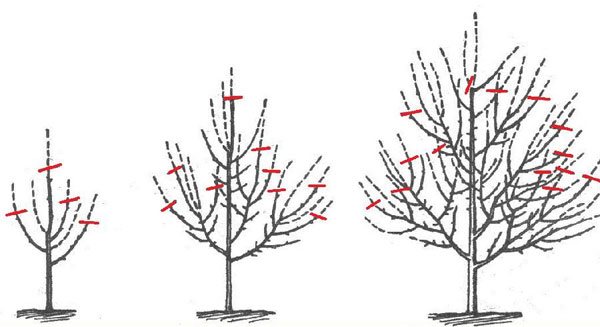

Apple tree pruning scheme.
When pruning an apple tree, remove from it:
- Sick and damaged branches;
- Growing down and touching the ground;
- Growing vertically upward (tops);
- Growing too close together.
Pruning is carried out during the vegetative dormancy of the tree., i.e. late autumn or early spring. The cuts are covered with garden pitch, and the cut branches are taken out of the garden.
Watch the video on how to properly trim the Semerenko apple tree:
Fertilization timing
Fertilize the apple tree in the spring - in April-May, and in the fall - in the month of September.
Nitrogen-containing mixtures are chosen for spring feeding., such as the:
- Urea,
- Ammonium nitrate,
- Ammonium sulfate,
- Humus,
- Manure or bird droppings.
Attention! In dry weather, fertilizers are diluted in water and watered under the tree trunk circle. In wet weather, fertilizers are embedded in the soil, loosening the ground under the crown.
With autumn top dressing, potassium-phosphorus fertilizers are applied to the soil, necessary for laying the future harvest. It can be potassium sulfate and superphosphate, wood ash.Nitrogen fertilizing is not applied in autumn, so as not to cause rapid growth of shoots on the eve of winter.
With a lack of microelements, foliar feeding is done during the summer. For this, Kemira Lux, Aquarin and any other preparations containing copper, zinc, iron, magnesium, sulfur and boron are suitable - necessary for the good growth of the tree.
Fertilizer is diluted in the specified amount of water and sprayed on the entire crown of the tree in the late evening or early morning. The term for such top dressing is 2-3 weeks after the flowering of the apple tree.
Semerenko apples: description and characteristics of the winter variety
Semerenko apples (Malus domestica Reinette Simirenko) are a winter variety of apples. Its origin is not known; he was the first to describe it and introduce it into the catalog of varieties by L.P. Simirenko back in the 19th century (he got into the State Register only in 1947). He also began to breed this variety in his gardens.
Currently, this variety is widespread in the southern regions of Russia.
In this material, we will analyze what characteristics the Semerenko apple trees have, how valuable they are, what the taste of their fruits is, how to plant such a tree on your own plot, how to properly care for it, and also which regions are suitable for breeding such apples.
Semerenko is a winter apple variety that grows in regions with a mild climate and moderate short winters. Trees of this species are undersized with a spreading crown prone to thickening. They bear early fruiting, give a crop already from the 4th year after planting.
The bark of such trees is dark gray in shaded areas and reddish in areas with good sun exposure. The variety is distinguished by its early flowering. Produces large, asymmetrical fruits with growths characteristic of this hybrid, which can have a diameter of 7 mm.
The color of the fruits themselves is green, if the apple tree grows in the sunny part of the garden, they may have pink sides. The characteristic features of the presented variety can also be considered:
- Pollinating varieties: Aydored, Golden, Delicious, Korey, Kuban spur, Memory of Sergeev.
- The height of the tree. Up to 3.5 meters.
- Barrel diameter. Up to 10 cm.
- Life Span. Several decades - up to 60 years.
- Fruit size. Large, apples weigh up to 200 grams.
- Winter hardiness. The variety is not resistant to severe frosts, they can damage the bark, after which fruiting can stop for 3 years. For this reason, it is recommended to cover apple trees for the winter.
- Features of the root system. Branched, most of the roots are buried in the ground by 50-60 centimeters.
- Productivity. Young apple trees produce up to 15 kilograms of apples per year. Trees over 10 years old can produce up to 100 kilograms per year, subject to all agricultural requirements.
- Cyclic fruiting. Semerenko begins to bear fruit from 4-5 years after planting. Up to 10 years, it gives a harvest annually, after 10 years the cycle of fruiting is reduced to once every two years or more.
- Self-fertility. When self-pollinated, the variety gives no more than 11% productivity.
The yield of the presented variety directly depends on the quality of the soil on which the tree grows. If it contains a sufficient amount of nutrients, apple trees will bear fruit well and for a long time. if the soil is poor, the harvest will be poor, and the fruiting period will increase every year.
The presented variety is susceptible to various diseases, including powdery mildew, scab, various types of moniliosis. To prevent the development of such diseases, trees must be treated with broad-spectrum insecticides at least once a year. You also need to monitor the regularity of watering and the fulfillment of other requirements for agricultural culture.
How to spray an apple tree in spring, read here.
It is necessary to spray trees even before bud break. Otherwise, it will not be possible to eat the fruits from the treated tree, as they will contain substances harmful to humans.
Fruit taste
Apples of this variety have a pleasant fine-grained pulp, their taste is sweet and sour, balanced. Fruits contain iron, vitamins B, C, E, manganese, potassium, carotene and biotin are also abundant in them. They are recommended for use by people of different ages for therapeutic and prophylactic purposes.
Find out how apples are useful here.
Semerenko are widely used in dietary nutrition, as they reduce the level of cholesterol in the blood, raise hemoglobin, and also accelerate metabolic processes.
The taste characteristics of apples are preserved only in the first six months of storage. After that, the pulp itself becomes looser, the pleasant sourness of the fruit is lost.
Semerenko is simple in the agricultural technique of planting and further care, even novice gardeners can cope with the presented variety. In order to get strong, strong trees that will be distinguished by high productivity in the future, it is recommended to use cuttings for planting them (it is better to purchase them in large agricultural farms).
Tree planting is carried out in the summer in clear warm weather. Further care for the presented variety includes watering, feeding, mandatory regular pruning. Fruits are harvested in mid-autumn. You can store the crop all winter, it will not lose its taste and nutritional properties.
Landing
Trees of the presented species are planted in warm regions on fertile soils. They are placed in those gardens where there are already pollinating varieties (or they are planned to be planted). If possible, they are placed in well-lit areas of the garden.
The soil is chosen more acidic; when choosing the placement of plants, preference is given to those areas where groundwater passes as close as possible to the root system.
It is possible to plant this type of fruit tree in sandy and scarce soils only if the owner of the garden can provide him with the necessary amount of fertilizers. Otherwise, the tree will not bear fruit.
Trees can only be planted during a period when the ambient temperature is between 23 and 30 degrees. It is better to choose a clear sunny day for this purpose.
The most suitable months for planting this variety is July; in some cases, you can postpone planting to the beginning of August.
In June, it is not recommended to carry out this procedure, since in some regions the temperature can drop below 23 degrees.
This link will tell you about planting apple tree seedlings in spring.
When grown in greenhouse conditions, planting apple trees can be carried out at any time. You just need to take care of the availability of good planting material, be it seeds or cuttings.
For the apple trees of the presented variety, holes are dug with a diameter of 1 meter and a depth of 60 cm. Organic fertilizers are necessarily introduced into the hole itself. The apple tree is placed in a hole, spreading the roots along its bottom.
When burying the root system, make sure that the fruit neck remains several centimeters above the ground level. The tree is additionally tied up in the first year.
Immediately after planting, the apple tree is watered abundantly, using 3-4 buckets of water for this.
If the apple tree is planted on sandy soils unsuitable for this variety, clay is placed in the hole, and already on it - plant residues with a layer of 15 cm.The tree itself is already planted on them.
To grow the Semerenko apple tree, you can use both the seed method and cuttings. The first one requires a great experience of working with the crop from the gardener; it is used mainly for breeding new varieties. Cutting is considered easier and can be recommended for novice gardeners. It is this method that allows you to get the harvest earlier.
To get healthy, productive trees, you need to be very careful when choosing cuttings for planting. It is necessary to take into account their compliance with the species characteristics of the variety, the presence of visible defects, the state of the bark. If you have any doubts about the quality of garden material, it is better to refuse to buy it.
The distance between trees is determined depending on how many apple trees the gardener wants to plant in his garden. If they are planted in a heap, you need to maintain a distance of 4-6 meters between them. If you plan to plant only 2-3 trees on the site, then they need to be planted at a distance of 4 meters between the trunk circles.
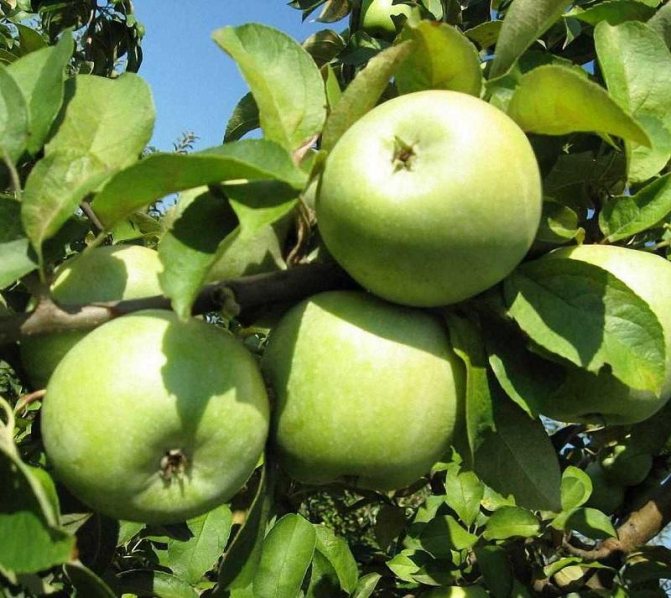

Table: Correct spacing between fruit trees when planting.
When planting plants, keep a distance not only between apple trees of the same species, but also between other fruit trees and shrubs placed on your site. It should also be at least 4 meters between the trunk circles. Otherwise, the tree will not be able to develop normally.
In order for this variety to maintain its productivity, it is extremely important for them to be properly cared for.
It provides for watering at least 3 times per season (in arid regions it can be done more often), pruning (since the apple tree tends to thicken the crown), spring feeding, mulching, as well as sheltering trees for the winter. Also, the gardener needs to take care of protecting the plant from diseases and pests.
To protect the presented variety from rodents, apple trees must be whitened in the spring. Otherwise, hares can ruin the tree. Violation of the requirements for agricultural technology can lead to a decrease in the yield of the presented crop.
This article will tell you about whitewashing apple trees in spring.
Top dressing
To increase the yield of the apple tree, a series of dressings are used. These include:
- Mineral fertilizers, manure. They are introduced into the soil in the autumn.
- Nitrogen fertilizers. They are introduced in the spring to improve the vegetation of the plant.
- Ammonium nitrate or ammonium sulfate. It is introduced superficially into the trunk circle.
Phosphorus fertilizers are also applied at the border of the trunk circle. Small grooves of 30 cm are made for them. They can be made both in the spring and in the autumn.
Peat, humus, and compost are additionally used for mulching the soil. They are introduced into the trunk circle at the end of autumn. This is necessary in order for the tree to winter well. It is especially important to mulch trees with roots close to the surface.
Fruit ripening
Ripening of apples usually occurs in September. In this regard, the harvest is carried out from mid-September to mid-October. 90% of the fruits have a good presentation and are suitable for further sale.
The sale of apples of the presented variety is usually postponed until the winter months. During this period, they have practically no competition among apples grown in our latitudes. This allows the owners of the gardens to get the maximum profit from their sale at the specified time.
Fruit storage
Semerenko apples can be stored raw in large wooden boxes lined with hay or other soft fillers. You can also make preserves, jams, compotes and other types of home preservation from the fruits. They allow you to store the harvest for several years. Many recipes for the preparation of such preservation make it possible to preserve the beneficial properties of the fruit.
Check out these articles as well
- Tomato juice recipes for the winter
- Grape variety Augustine
- Sprouting potatoes
- The best early varieties of cherries with descriptions and photos
Features of fruiting and ripening
Attention! For successful fruiting, this variety needs pollinators growing at a distance of 100-150 m from the tree. The Simirenko apple tree blooms in the last decade of May and apple trees blooming at the same time will become pollinators for it.
Young trees bear fruit annually, but at the age of 25-30 years, there comes a periodicity of yield, those. one year the apple tree bears, and the next rests.
The technical ripeness of apples occurs in late September - early October. When removed, they are dense and sour, but after a month of storage they lose some of the sourness and become softer.
The main advantage of the Simirenko apple tree is its the crop can be stored for 8-9 months after harvest! No other variety can boast of such keeping quality!
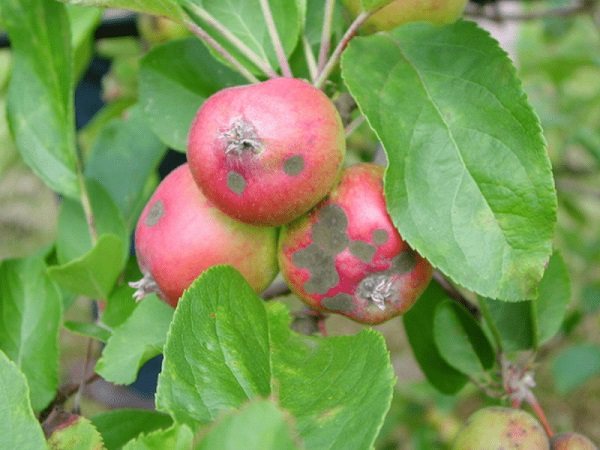

Renet Simirenko is the most "lazy" of the known varieties of apple trees.
Rules for storing apples, so that they delight you until next summer:
- Apples taken from a tree in dry weather are suitable for storage.
- Before storage, you need to inspect each apple, selecting only whole fruits without damage, bruises and wormholes.
- Selected apples are packed in cardboard boxes or wooden boxes. It is important that the container is dry and clean.
- Packaged apples are placed in a cold place with a temperature of 1 to 8 ° Ϲ. This can be a refrigerator, a cellar, an underfloor of a house, or an insulated balcony.
Advice! Processing the apple with propolis solution will help to increase the shelf life.
Elimination of periodicity
In the variety of Simirenko apples many gardeners are not satisfied with its frequency of fruiting.
Why does an adult apple tree not bear fruit every year? This is due to the fact that in adulthood, the tree needs more nutrients to form a crop and preserve its crown.
In order for the tree to begin bearing fruit annually, you need to cut it off, removing up to a quarter of the crown, and feed it well.
Then it will begin to actively form spears and fruits, on which the future harvest is formed.
Harvesting and storage
They start collecting products at the end of September. I only do it manually. The weather outside should be dry and sunny.
Apples hold on tightly to the branches, rarely fall, even in strong gusts of wind and storms. After collecting, they are carefully folded into boxes. It is advisable to wrap each fruit in paper, or sprinkle with wood shavings between the rows.
The harvest is stored in a cool room. The temperature should be in the range of 1-8 ° C, and the humidity should be 85-90%. It is desirable that this place is well ventilated.
If everything is done correctly, then the fruits will lie until the end of April. To extend the time, they are treated with a propolis solution.
Apples lose their juiciness during storage, the flesh becomes loose and grainy. Therefore, many gardeners prefer to recycle them. Juices are obtained from fruits, they are dried, jams and preserves are made.
Varieties and variants
When buying a seedling, it is important to know not only the characteristics of its variety, but also the type of rootstock to which it is grafted. What are they and how are they different?
Vigorous or clonal stock
Produces the tallest and most unpretentious tree. It lives more than 50 years, grows up to 7 meters in height, but will enter fruiting only for 6-7 years after landing.
Important! Such trees are not planted in small areas and in soils with high groundwater levels.
Semi-dwarf
This rootstock reduces tree growth up to 4.5-5 meters height, and lifespan - up to 40 years... A semi-dwarf apple tree will begin bearing fruit in 4-5 years, and get along well with groundwater at a level of 2.5-3 meters.
Dwarf
This rootstock gives a quick introduction. in fruiting - for 2-3 years after landing! But it does not live long - 25-30 years, growing no more than 2.5-3 meters in height.
Columnar
There are no cultivars of columnar apple with the name Simirenko, so we will briefly describe columnar apple trees in general.
They are very compact, they can be planted in 50-70 cm increments. They grow no higher than 2.5-3 meters in height and bear fruit well for the first 10-12 years of life.
Similar varieties
The main advantage of the Simirenko variety, due to which it has been so popular for more than a hundred years, is long storage and great taste of apples. The varieties will be similar to it:
- Antaeus;
- Antonovka;
- Ranet Chernenko;
- Zhigulevskoe;
- Granny Smith.
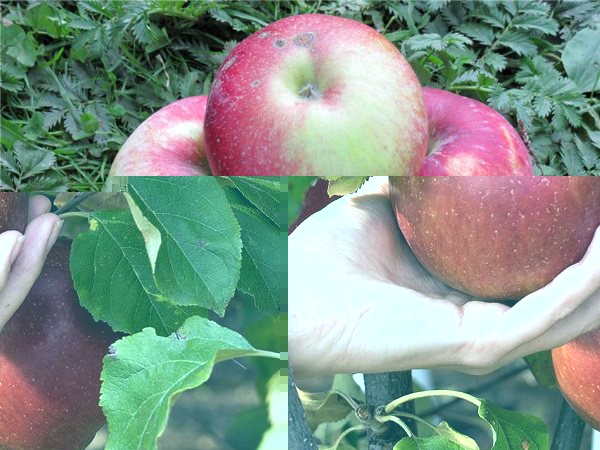

Antaeus.
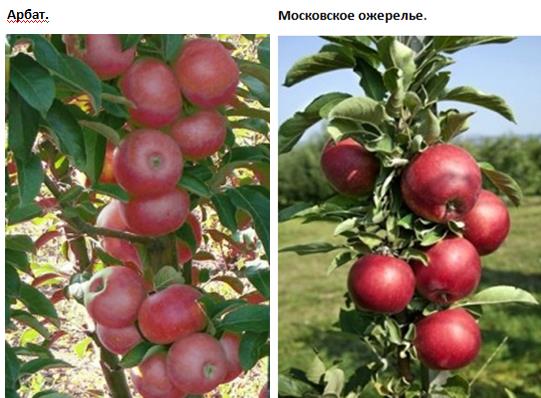

Antonovka.
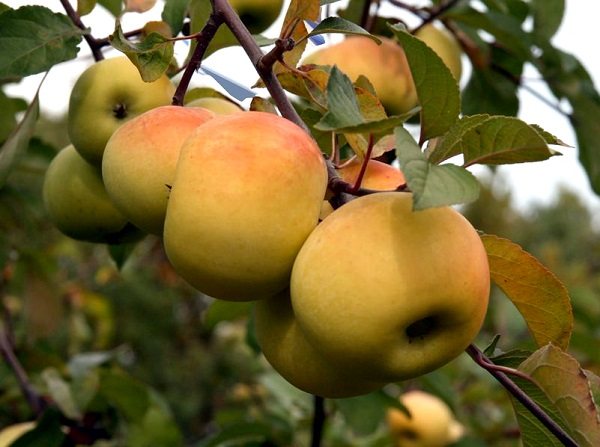

Ranet Chernenko.
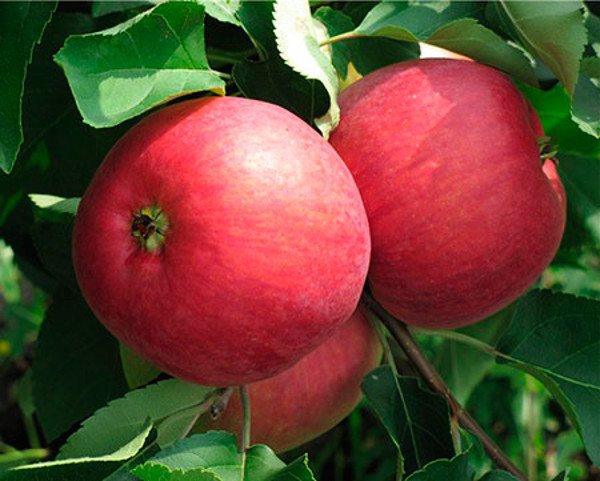

Zhigulevskoe.
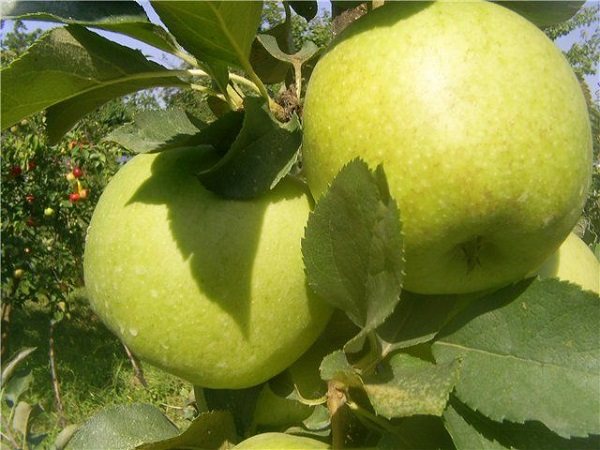

Granny Smith.
Growing in different regions
Apple tree Ranet Simirenko is recommended for cultivation in the southern regions of Russia and the Central Black Earth Region.
Caution! In central Russia, this variety can freeze slightly during cold winters with little snow cover.
Based on the experience of gardeners, the tree freezes every 4-5 winter, sometimes losing all of its crown.
Regions where planting Simirenko does not make sense:
- In the Urals;
- In Siberia;
- In Moscow and Moscow region;
- In the Leningrad region;
- In the North-West of Russia and in other regions with cold winters.
Breeding history
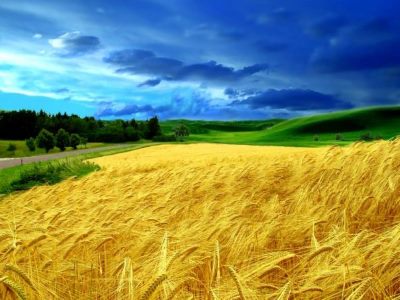

"Renet Simirenko" became widespread when it first appeared on Platonov farm in the Cherkasy region in Ukraine... The owner of the garden, L.P.Simirenko, accidentally discovered this variety and was very puzzled.
It is still unclear whether the tree grew from an unknown seed or belonged to the old forgotten varieties. Subsequently, "Simirenko" was actively cultivated and spread throughout the world.
External differences
You can distinguish an apple tree of this variety by the fruits and leaves of the tree. Leaves this apple tree kind of bent in half at an angle of up to 90 °, but the tip is elongated and twisted, which is rarely found in other varieties of apple trees. The leaves themselves are smooth and slightly shiny.
Distinctive feature of the apple Simirenko - the presence on it convex outgrowth, similar to a wart, 2-3 mm in height and up to 7 mm in width. There can be from 1 to 3 such formations.
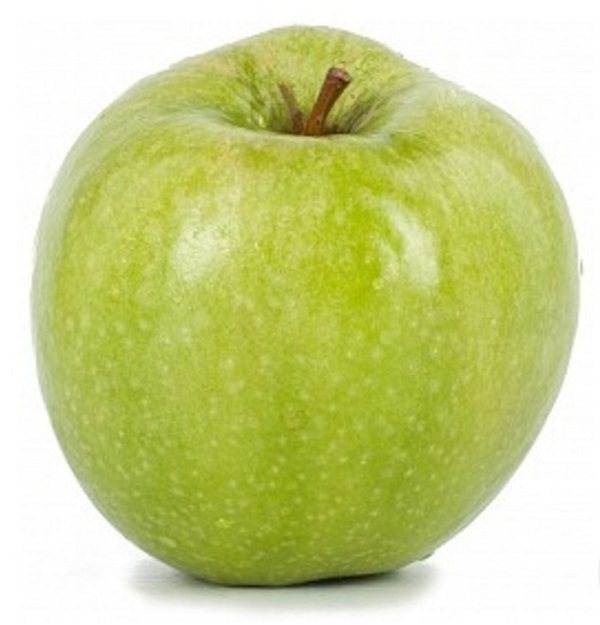

An overgrowth on an apple near the stalk is one of the hallmarks of the Semerenko variety.
Fruit
Semerenko apples are very tasty, tender, with a pronounced wine flavor. They are sweet and fragrant. The skin color is even green with dark spots. On the skin there are specific growths inherent in this variety.
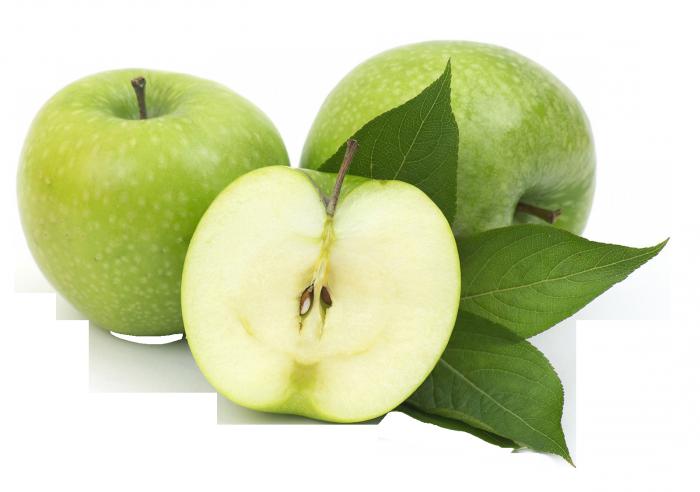

The pulp is white, slightly greenish, creamy during storage. It is juicy, very tasty, suitable for making juices. The weight of one fruit is average, from 180 to 200 g. Apples of this variety have excellent transportability. Fruit size, appearance and taste are highly dependent on growing conditions.
Why doesn't it bear fruit?
Young tree
Does not bear fruit, does not bloom
And slowly growing
The most common cause of this condition is protracted adaptation of the plant to new living conditions. This happens if:
- The seedling is planted too deeply, the root collar is located below the soil level;
- He lacks trace elements in the soil;
- The roots of the tree are damaged by pests: moles, shrews;
- Roots rot due to the high standing of groundwater;
- The tree is sick or is attacked by aphids that suck sap from it.
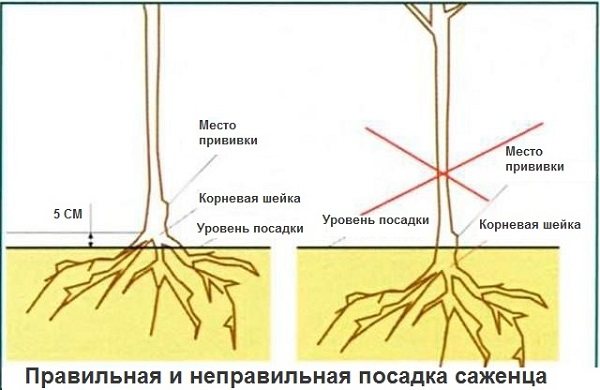

When planting, do not deepen the root collar.
What to do:
- Examine the tree for aphids, unusual spots, and plaque on the leaves. If there are any, treat the tree from pests and diseases.
- Feed the apple tree with mineral fertilizers containing iron. In spring - nitrogen-containing, in autumn - potassium-phosphorus.
- If the root collar is deepened, dig in the tree from all sides and carefully lift it with a shovel under it.
- With a close location of groundwater, transplanting a tree to a new, high place will help. You can wait for the tree to adapt or die.
Important! The fastest top dressing is “on a green leaf”. It is performed by sprinkling the crown of the apple tree with a weak solution of fertilizers.
But grows well
This could be due to:
- Excessive growth of shoots (the plant "fattens"). If a tree expels many shoots with rich green foliage, then it has no time to bear fruit. The normal growth rate for an apple tree is 45-50 cm per season. If this figure is higher, you may have overdone it with nitrogen fertilizing.
- Vertical growth of branches interferes with the formation of ringlets and fruit (branches on which the future harvest is formed). In such cases, a trellis is made near the tree and branches are carefully tied to it, placing them vertically.
- Lack of iron in the soil not only slows down the growth of the apple tree, but also prevents fruiting. How to feed the tree:
- a solution of ferrous sulfate (1 teaspoon per 8-10 liters of water) on a green leaf.
- solution of the drug "Ferovit" (4 drops per liter of water) on a green leaf.
- any iron products (nails, staples, etc.), burying them under the crown of the apple tree.
Blooms but does not set fruit
Possible reasons this state:
- There were frosts during flowering;
- The tree was not pollinated due to extreme heat or rain during flowering. In such weather, pollinating insects stop their flight.
- During flowering, the tree was treated with pests that are dangerous to bees.
- At the first flowering, the ovary may not form.
Bloomed, ovaries formed, but quickly fell off
Partial dropping of the ovary in June is a measure by which the tree regulates its load. But if all the ovaries fell from the tree, the reason may be:
- Aphid activity on young shoots of a plant. It sucks out the juices from the plant, which are needed to form apples, and the tree sheds the ovaries;
- Fungal diseases such as powdery mildew, late blight, apple cancer.
- Freezing of a tree in the previous winter.
An adult tree does not bear fruit
The reason may be transition to periodic fruitingcharacteristic of mature trees of some varieties, including the Simirenko apple tree.
Diseases and pests
Of course, talking about cold and frost, one cannot fail to mention another, but no less dangerous threat to the plant, which is numerous fungi, bacteria, viruses, insects and parasites.
Unfortunately, despite the fact that the discussed apple tree has immunity to most of them, it is still rather poorly protected from powdery mildew, as well as scab. However, if you follow the rules of prevention, you may well never face these ailments.
The best and, by the way, the most effective method of prevention is the regular thinning of the crown, which must be carried out by removing old and painful leaves.
If you do not do this constantly, then soon an infection may develop in some leaves, well, and if it continues to spread throughout the plant, then the apple tree may die, so be always on the lookout.
The most important thing is to check the young leaves, since the disease prefers them. But the source of the disease is those leaves that were not removed from the ground after falling off last year, and therefore you definitely should not underestimate the autumn harvesting of leaves: their absence can lead to dire consequences.
However, suppose that for some reason you still could not avoid infection, and the apple tree became infected with one of the above diseases. What to do then?
First of all, it is necessary to suppress the attempts of a huge number of gardeners to treat absolutely any infection with a Bordeaux mixture that meets on their way. It is certainly a good medicine, but make no mistake: it cannot cure absolutely anything.
In addition, this liquid has a very detrimental effect on the growth of new young leaves, and therefore, before resorting to such radical methods, it is necessary to think carefully about your actions and make an accurate diagnosis.
If the disease is mild, then we advise you to use some weak fungicide, which are on sale in immeasurable quantities.
We recommend that you use the same preparations if the summer before harvest was incredibly dry and hot, because even if your plant was not sick with anything, these weather conditions are incredibly favorable for diseases. Therefore, an extra preventive measure will definitely not hurt you.
This is done two to three weeks before the immediate collection of apples, since otherwise the disease can infect not the tree, but themselves, and in this case the fruits remaining in storage can rot at any time, and you cannot cure them. you can.
By the way, during processing, in no case should you pay to the hidden one - the lower part of the leaf is less attention than the upper one, since it is from below that cunning infections prefer to hide - so that it is more difficult for you to find them.
Weeds are also extremely active and harmful carriers of harm, which will help you to cope with high-quality mulching, which simply will not allow any litter to receive the solar energy necessary for growth.
Also, of course, when a large number of weeds appear, it will be necessary to carry out weeding, which will also allow you to get rid of insects, which are very fond of burying underground.
If you want to provide your tree not only with good protection against a specific disease, but with a stronger immunity in general, then urea can help you with this. One spraying in the earliest spring can be an excellent helper in the fight against diseases.
Also, urea is incredibly useful because it kills insects that have accumulated in the bark and, of course, under it over the previous year. Waking up after a long hibernation, they could cause enormous damage to your tree, and therefore treatment with urea is simply necessary.
We must not forget that most often such large fruit trees are affected by an ordinary garden aphid, which, rest assured, is found in you, and therefore, if you want to protect yourself from it, always check the undersides of the leaves for its presence, as well as if found, immediately prepare a soapy solution. In the event of a small invasion, he will drive away the aphids, and if the insects have accumulated a mass, then you will have to use insecticides.
Useful Tips
- Planting an apple tree throw any iron products into the planting hole: nails, nuts, screws. This measure is good prevention of iron deficiency for a long time.
- If an apple tree every year aphid attacks - somewhere near the tree there is an anthill. These insects specially carry aphids to trees, feeding on the sweet nectar that aphids get. Fight the ants on the site, and the trees will be safe!
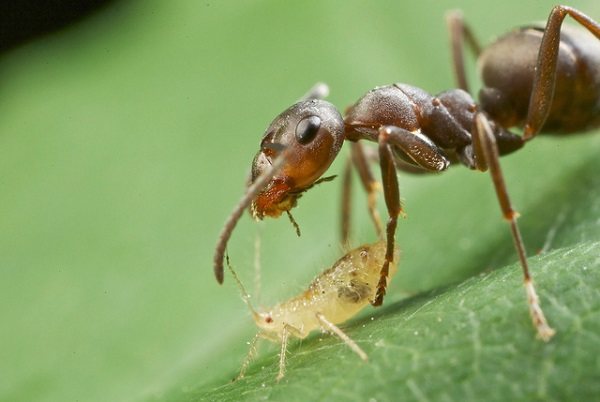

It is imperative to fight ants on the site.
- Before boarding apple tree, place its roots for 5-6 hours in weak Kornevin solution... So the seedling will quickly restore the root mass.
Where is better to plant
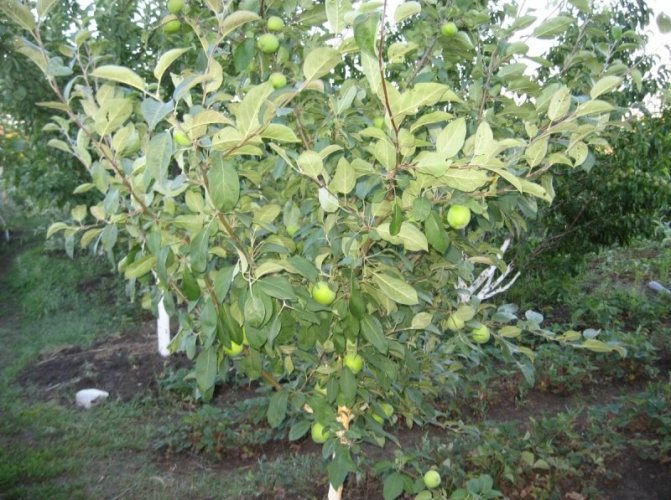

If you plan to plant "Semerenko" apple trees on your site, then you need to start preparing the pits in advance. The whole secret is that pits for seedlings of this variety are prepared in 6, or better 12 months, and well-lit places are selected for their creation.
It is also very important that the soil on the site is not waterlogged and not washed out by groundwater. If the groundwater is located very close to the surface at the planting site of cuttings, then it is necessary to properly equip the drainage layer.

